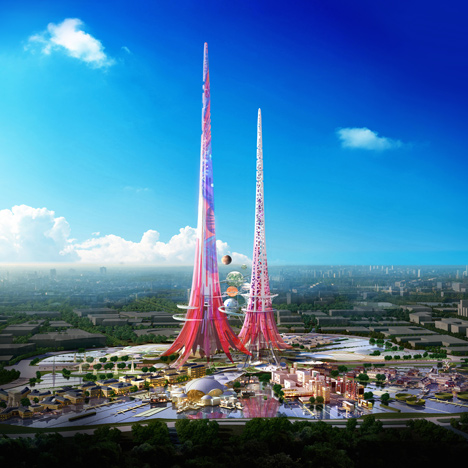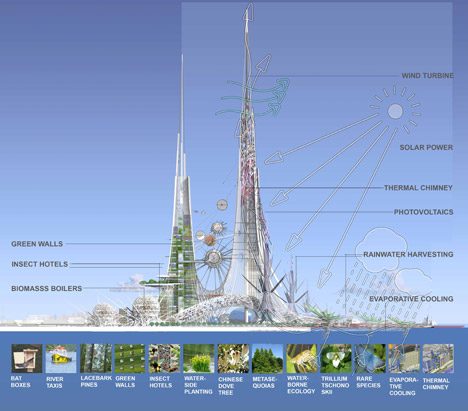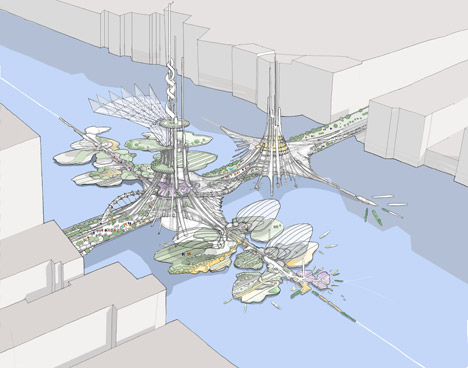Chetwoods creates "blatantly iconic" kilometre-tall tower to act as environmental filter for Wuhan
News: British studio Chetwoods has unveiled a proposal to create the world's tallest tower in the Chinese city of Wuhan, with a host of environmental functions that will attempt to purify the city's polluted air and lakes.
The Phoenix towers, the tallest of which reaches a kilometre at its highest point, were commissioned by China's Hua Yan Group to be an "iconic" attraction for a 47 hectare master plan occupying an island in one of Wuhan's many lakes.
When completed, the larger will be the world's tallest structure, towering over 150 metres above the world's highest building, the Burj Khalifa.
Based on a 2009 competition-winning proposal Chetwoods developed for creating a new bridge in London, the firm was asked to create a proposal that could incorporate large-scale environmental functions as well as provide a focal point for a three kilometre long avenue.
The tallest of the two towers contains multiple filtration systems for cleaning the water from the lake and the surrounding air as well as solar electricity plants.

The second structure features a perforated facade with a louvre system for ventilation and light control and contains a vast vertical garden as well as restaurants, galleries, bars and other leisure facilities. The towers will occupy a seven-hectare space.
"In China if you come up with a slightly mad idea, its almost not mad enough," studio founder Laurie Chetwood told Dezeen. "It's the opposite of the UK."
"It was blatantly iconic," said Chetwood. "They wanted to take the Eiffel Tower experience on a stage further. It doesn't just stand there and become an iconic symbol of Wuhan, it has to do a job. We've applied as many environmental ideas as we possibly could to justify the shape and the size of them."
Both towers, which have been created in collaboration with engineers WSP, have a steel superstructure and concrete core and base.
The bottom of each tower has been designed to emulate the raised root system of a mangrove tree, with buttresses connecting each structure to the ground creating an open space underneath and around the base for tourist-focused functions.
"The Chinese are very commercially minded, as you can imagine," said Chetwood. "This is a big tourist idea right in one of the largest lakes in Wuhan. They've turned on to the environmental idea but there's always obviously the commercial element at the base of it."

Only half of the taller tower will be habitable, with the upper portion devoted to mechanical functions. It is being designed to act as a "thermal chimney", with the top being heated by the sun and drawing cool air up through its filtration systems.
"We will do the same with the water, so the water is drawn up through the tower, it's cleansed and then put back into the lake," explained Chetwood, adding that the height of the tower would play a key part in its functionality.
"It had to be something pretty stunning to catch the eye from three kilometres away. But there is quite a lot in the height that is not just showcasing, a lot of it is to do with the environmental side as well."
Other environmental features include photovoltaic cladding, wind turbines, biomass boilers and hydrogen fuel cells.
The design of the towers is based on symbolism around the mythological Fenghuang – the Chinese phoenix, which is represented by both a male and a female bird.

"It's a fairly stereotypical image," explained Chetwood who said that the taller tower was the male, containing most of the active environmental functions and feeding clean, cooled air and water and electricity into the more "passive" female tower.
Chetwood said the design was also a response to some of the criticism about Western architects creating projects in China that did not bear any relation to local context.
"It's a force for good really because there's been quite a lot of criticism of these Western-driven designs, almost irresponsible design," he said. "This is meant to be embracing the culture with the phoenix/dragons idea but it's also doing a really top environmental job and taking into account environmental factors around the towers."
Chetwood expects the project to start on site within the next year and take at least three years to complete.
At the end of last year, Dutch architecture firm 3XN completed a shopping centre in Wuhan, with a facade covered in silver balls.
In 2011, Adrian Smith and Gordon Gill began work on site for a kilometre tall skyscraper in Jeddah. With more habitable space than Chetwood's towers, the Kingdom Tower will be the world's tallest building.